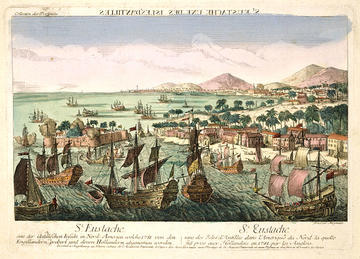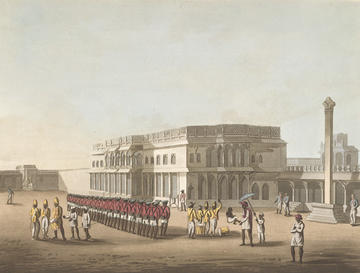The European Fiscal-Military System and the Wider World, 1530 - 1870
Not surprisingly, for a project on the early European fiscal-military system that has been funded by the European Research Council, our project has so far been firmly focussed on Europe. Yet the parallels between the European experience and that of the wider world are increasingly insistent. This blog post is a first attempt to think through some of these, and to invite – or incite? – comments about what the wider concept of a fiscal-military ‘system’ has to offer to global historians.

The capture of St Eustatius, 1781
First though, a reminder of what the early modern European fiscal-military system was. As a concept it pushes back against an older scholarship which looks at state formation in Europe as a matter of national resource mobilisation in which states such as Britain or France were autarkic or self-sufficient, and where their military performance therefore reflect their capacity to extract these resources. Though recognising the importance of local resources, the concept of the fiscal-military system suggests that early modern states were embedded into a wider international structure of resource mobilisation, being dependent as well on other states to help provide specific resources, ranging from intelligence or expertise all the way up to men, money and war materiel. These resources flowed through major ‘hubs’, above all Amsterdam, which were linked together by economic and social networks that crossed national borders and enabled states to find the resources for war. In the British case, for example, London proved a hugely important hub, enabling Britain to build its entire state on the basis of being able to rent soldiers from allies in wartime, enabling it to ‘surge’ its military capacity and mobilise quickly at the outbreak of war at a high financial but a low political cost, and then drop them when it ended.
What I want to suggest is that this model not only helps to explain the processes of fiscal-military mobilisation outside early modern Europe, but actually works even better, as an explanation of imperial and colonial state formation. As the work by David Armitage, Eliga Gould and others have shown, the early modern Atlantic was a world of ‘entangled histories’, where close proximity and weak state capacity made it even easier for networks to move resources across national borders, despite the efforts to enforce trade barriers. The example of Amsterdam as the free trade hub of Europe was mirrored in the Caribbean by the Dutch island of Sint Eustatius, a free port where British, French, Spanish, Portuguese and other merchants could trade provisions, sugar, rum and a range of military resources. Indeed, it proved so vital a hub for American and French armies during the American Revolutionary War that Admiral Sir George Rodney chose to besiege the island in 1781 rather than sail north to relieve General Charles Cornwallis in Virginia, losing the war for America. Much the same role was played by Cape Town in southern Africa, a neutral port for much of the eighteenth century where foreign ships could stop for provisions and military resources. Although the hiring or subsidising of soldiers was less centralised than in Europe, reflecting a lack of urbanisation in the Americas outside areas of European settlement, frontier towns such as Albany or Quebec nevertheless acted as crucial points of contact between European settlers and Native American groups. And the presence of German troops in British armies during the American Revolutionary War is a reminder of the impact and reach of the European fiscal-military system itself.
This becomes even clearer when we look at Asia. As numerous historians have shown, national borders and identities were equally fragile, and settlements such as Singapore, Penang in Malaysia, Hong Kong and Canton (Guangzhou) in China and many others were important neutral hubs in the flow of money, weapons and other military resources across the Indian and Pacific oceans. Emrys Chew has noted, for instance, the importance of Singapore as a hub for illegal gun-running in the early nineteenth century, which undermined Dutch rule in Java (now Indonesia) and eventually led to an arms control agreement between the European powers in 1897.

Sepoys at the palace of Tipu Sultan in Bangalore, 1804
The most important canvas though for thinking about a fiscal-military system is South Asia or India. During the early modern period it saw the decline of a central, albeit highly diffused and devolved, Mughal state and its fragmentation into a number of competing regional powers, of which the British East India Company was one. As in Europe, all these powers looked to local resources to assist their military competition, in particular the vast early modern Indian military labour market that Dirk Kolff described. Autonomous princely states had formerly sold their services to the Mughal Empire, and as this crumbled they began to seek other paymasters, who hired this ‘foreign’ manpower for their own conflicts; Kolff describes for example the hiring of the Bundela Rajputs from central India by zamindars or provincial elites in Madras (now Chennai), some 550 miles to the south. Indian princes such as Tipu Sultan, in the Kingdom of Mysore in southern India, made increasing use of French and wider European experts and resources his conflicts with the Marathas and then with the East India Company. The Company itself was also hiring increasing numbers of men as sepoys through its hubs of Bombay (now Mumbai), Madras and Calcutta (now Kolkata), enabling it after 1757 to begin to consolidate its political and fiscal-military power in South Asia and eventually to suppress competing states such as Mysore and the Marathas. Drawing heavily upon ‘foreign’ money and materiel in this process, the Company tapped into what might be called the ‘South Asian fiscal-military system’ to provide it with the resources necessary for war. Randolf Cooper describes, for instance, the logistical infrastructure which underpinned Wellington’s campaigns against the Marathas at the turn of the nineteenth century. He relied heavily upon local grain and bullock contractors. Like their counterparts in the Low Countries, repeated warfare had made them familiar with the needs of armies on campaign, and they were willing to hire their services to anyone who could afford them, which the East India Company could but the Marathas eventually could not.
The early modern European fiscal-military system should therefore be an important model for thinking about global state formation during the early modern period, not just the consolidation of European imperial power but also the experience of Indian and American state-building during the early modern period. It helps to explain the importance of major hubs characterised by a free trade in men, money and materiel, across national borders and identities, which could support and sustain but also upset and undermine the power of European empires. It is concept, I would like to suggest, that has much to contribute to the history of the world beyond Europe.




